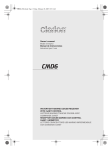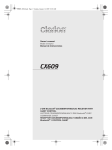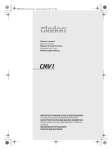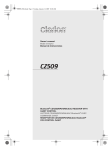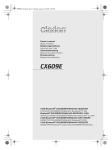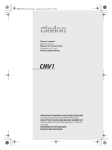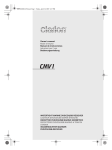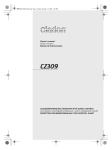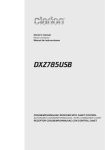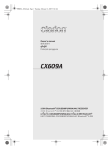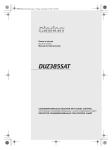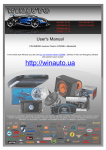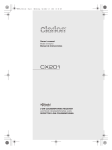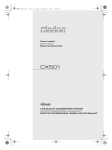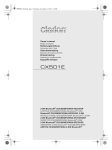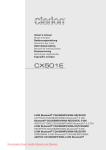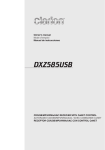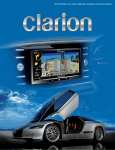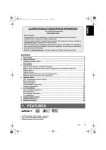Download Clarion M309 Owner`s manual
Transcript
M309_ENG.book Page 1 Monday, February 23, 2009 3:04 PM Owner’s manual Mode d’emploi Manual de instrucciones Istruzioni per l’uso M309 MARINE CD/USB RECEIVER WITH CeNET CONTROL LECTEUR MARINE CD/USB AVEC COMMANDE CeNET RECEPTOR CD/USB MARINO CON CONTROL CeNET LETTORE CD/RICEVITORE USB MARINO CON CONTROLLO CeNET M309_ENG.book Page 2 Monday, February 23, 2009 3:04 PM CAUTIONS: This appliance contains a laser system and is classified as a “CLASS 1 LASER PRODUCT”. To use this model properly, read this Owner’s Manual carefully and keep this manual for your future reference. In case of any trouble with this player, please contact your nearest “AUTHORIZED service station”. To prevent direct exposure to the laser beam, do not try to open the enclosure. !CAUTION USE OF CONTROLS OR ADJUSTMENTS OR PERFORMANCE OF PROCEDURES OTHER THAN THOSE SPECIFIED IN THE OWNER’S MANUAL MAY RESULT IN HAZARDOUS RADIATION EXPOSURE. ADVARSEL. Denne mærking er anbragt udvendigt på apparatet og indikerer, at apparatet arbejder med laserstråler af klasse 1, hvilket betyder, at der anvendes laserstråler af svageste klasse, og at man ikke på apparatets yderside kan blive udsat for utilladelig kraftig stråling. APPARATET BØR KUN ÅBNES AF FAGFOLK MED SÆRLIGT KENDSKAB TIL APPARATER MED LASERSTRÅLER! Indvendigt i apparatet er anbragt den her gengivne advarselsmækning, som advarer imod at foretage sådanne indgreb i apparatet, at man kan komme til at udsaætte sig for laserstråling. 2 M309 OBS! Apparaten innehåller laserkomponenten som avger laserstrålning överstigande gränsen för laserklass 1. VAROITUS Suojakoteloa si saa avata. Laite sisältää laserdiodin, joka lähettää näkymätöntä silmille vaarallista lasersäteilyä. M309_ENG.book Page 3 Monday, February 23, 2009 3:04 PM CLARION PRODUCT REGISTRATION INFORMATION For USA and Canada only www.clarion.com Dear Customer: Congratulations on your purchase of a Clarion mobile electronic products. We are confident that you’ll enjoy your Clarion experience. There are many benefits to registering your product. We invite you to visit our website at www.clarion.com to register your Clarion product. We have made product registration simple with our easy to use website. The registration form is short and easy to complete. Once you’re registered, we can keep you informed of important product information. Register at www.clarion.com - it’s easy to keep your Clarion product up to date. INFORMATIONS DE L’ENREGISTREMENT DE PRODUITS CLARION Pour les Étas Unis et le Canada seulement www.clarion.com Cher client: Nous vous remercions d’avoir acheté ce produit électronique mobile Clarion. Nous sommes confiants que vous apprécierez votre expérience Clarion. Il y a beaucoup d’avantage à enregistrer votre produits. Nous vous invitons à visiter notre site Web www.clarion.com pour enregistrer votre produit Clarion. Nous avons facilité la tache d’enregistrement de produit simple et facile grâce à notre site Web. Le formulaire d’enregistrement est court et facile à compléter. Lorsque vous êtes enregistrer, nous pouvons vous tenir informé des informations important de produits. Enregistrer à www.clarion.com - c’est facile de mettre à jour votre produit Clarion. INFORMACIÓN DEL REGISTRO DE PRODUCT O DE CLARION Para USA y Canada nomas www.clarion.com Querido Cliente: Felicitaciones por su compra de producto electrónico móvil de Clarion. Estamos seguros que usted gozará de su experiencia con el producto de Clarion. Hay muchas ventajas al registrar su producto. Le invitamos a que visite nuestro sitio en internet www.clarion.com para registrar su producto de Clarion. Hemos hecho el registro de producto fácil en nuestro sitio. La forma de registro es corta y fácil de completar. Una vez que lo registre, podremos proporcionarle la información de su producto. Registrese en www.clarion.com - es fácil mantener su producto de Clarion actualizado. M309 3 M309_ENG.book Page 4 Monday, February 23, 2009 3:04 PM English Thank you for purchasing this Clarion product. ∗ Please do not use this product on vehicles. ∗ Please read this owner’s manual in its entirety before operating this equipment. ∗ Check the contents of the enclosed warranty card and keep it carefully with this manual. Contents 1. FEATURES ...................................................................................................................................... 4 2. PRECAUTIONS ............................................................................................................................... 5 3. CONTROLS ..................................................................................................................................... 7 Names of the Buttons and Their Main Functions ............................................................................. 7 4. DCP.................................................................................................................................................. 9 5. REMOTE CONTROL ..................................................................................................................... 10 Optional Wired Remote Control Unit Operations ........................................................................... 10 Wireless Remote Control Unit Operations ..................................................................................... 12 Inserting the Battery ....................................................................................................................... 13 6. OPERATIONS................................................................................................................................ 14 Basic Operations ............................................................................................................................ 14 Radio Operations ........................................................................................................................... 16 SIRIUS Satellite Radio Operations................................................................................................. 18 CD/MP3/WMA/AAC Operations ..................................................................................................... 21 Operations Common to Each Mode ............................................................................................... 24 7. ACCESSORIES ............................................................................................................................. 26 USB/MTP Operations..................................................................................................................... 26 iPod Operations.............................................................................................................................. 28 XM Satellite Radio Operations ....................................................................................................... 31 CD Changer Operations................................................................................................................. 33 8. TROUBLESHOOTING................................................................................................................... 34 9. ERROR DISPLAYS ....................................................................................................................... 36 10. SPECIFICATIONS ......................................................................................................................... 37 11. OTHERS ........................................................................................................................................ 38 1. FEATURES • Drip Shield Chassis • BBE MP for compressed audio improvement • Low Consumption Wating As Power Off 4 M309 M309_ENG.book Page 5 Monday, February 23, 2009 3:04 PM This equipment has been tested and found to comply with the limits for a Class B digital device, pursuant to Part 15 of the FCC Rules. These limits are designed to provide reasonable protection against harmful interference in a residential installation. This equipment generates, uses, and can radiate radio frequency energy and, if not installed and used in accordance with the instructions, may cause harmful interference to radio communications. However, there is no guarantee that interference will not occur in a particular installation. If this equipment does cause harmful interference to radio reception, which can be determined by turning the equipment off and on, the user is encouraged to consult the dealer or an experienced radio technician for help. CAUTION USE OF CONTROLS, ADJUSTMENTS, OR PERFORMANCE OF PROCEDURES OTHER THAN THOSE SPECIFIED HEREIN, MAY RESULT IN HAZARDOUS RADIATION EXPOSURE. THE COMPACT DISC PLAYER SHOULD NOT BE ADJUSTED OR REPAIRED BY ANYONE EXCEPT PROPERLY QUALIFIED SERVICE PERSONNEL. CHANGES OR MODIFICATIONS NOT EXPRESSLY APPROVED BY THE MANUFACTURER FOR COMPLIANCE COULD VOID THE USER’S AUTHORITY TO OPERATE THE EQUIPMENT. INFORMATION FOR USERS: CHANGES OR MODIFICATIONS TO THIS PRODUCT NOT APPROVED BY THE MANUFACTURER WILL VOID THE WARRANTY AND WILL VIOLATE FCC APPROVAL. Bottom View of Source Unit M309 5 English 2. PRECAUTIONS M309_ENG.book Page 6 Monday, February 23, 2009 3:04 PM English Flip Down Panel Handling Compact Discs This unit uses a flip-down structure that makes possible large-size displays. • Compared to ordinary music CDs, CD-R and CD-RW discs are both easily affected by high temperature and humidity and some of CD-R and CD-RW discs may not be played. Therefore, do not leave them for a long time in the boat. • Never stick labels on the surface of the compact disc or mark the surface with a pencil or pen. CAUTION When opening and closing the FLIP DOWN PANEL, be careful not to catch your fingers. They could be injured. 1. Always use this unit with the FLIP DOWN PANEL closed. 2. Do not force operations or use this device abnormally when opening or closing the FLIP DOWN PANEL. 3. Do not use the FLIP DOWN PANEL as a tray to place objects on when it is open. 4. When closing the FLIP DOWN PANEL, do not press the [OPEN] button. ∗ Press the center of the DCP to close. DCP 5. Strong impacts to the operating or display section can cause damage or deformation. 6. If the FLIP DOWN PANEL does not open fully, gently open it with your hand. 6 M309 Display Screen In extreme cold, the screen movement may slow down and the screen may darken, but this is normal. The screen will recover when it returns to normal temperature. M309_ENG.book Page 7 Monday, February 23, 2009 3:04 PM English 3. CONTROLS Names of the Buttons and Their Main Functions [DISP] [OPEN] [ [BND] [IR RECEIVER] ] [AUX] [SRC] [AUDIO] [ISR] [SCN] [RPT] [ROTARY] [ ], [ ] [RDM] [DIRECT] With the FLIP DOWN PANEL opened [Q] (EJECT) [CD SLOT] [OPEN] button [DIRECT] buttons • Deeply push in [OPEN] button to unlock the flip down panel. • Store radio stations in memory or recall it directly while in radio mode. [DISP] button [RDM] button • Switch the display indication. • Perform random play while in CD/MP3/WMA/ AAC/USB/iPod mode. [BND] button • Change bands, or select seek tuning or manual tuning while in the radio mode. [IR RECEIVER] • Receiver for remote control unit. (Operating range: 30° in all directions) [AUX] input jack • Input jack for connecting external device. [AUDIO] button • Press to switch to the audio adjust mode. [RPT] button • Perform repeat play while in CD/MP3/WMA/ AAC/USB/iPod mode. [SCN] button • Perform scan play for 10 seconds of each track while in CD/MP3/WMA/AAC/USB mode. [ ] (UP), [ ] (DN) buttons • Select folders while in MP3/WMA/AAC/USB mode. M309 7 M309_ENG.book Page 8 Monday, February 23, 2009 3:04 PM Names of the Buttons and Their Main Functions English [ROTARY] knob • Rotate to adjust the volume. [ISR] button • Recall ISR radio station in memory. • Press and hold the button (2 sec.) to store current station into ISR memory (radio mode only). [SRC] button • Turn the power on/off. [x], [v] buttons • Commence fast-forward or fast-reverse mode. [ ] button • Perform preset scan while in the radio mode. • Play or pause a track while in CD/MP3/WMA/ AAC/USB/iPod mode. [Q] (EJECT) button • Press to eject disc. [CD SLOT] • Insert CDs here. 8 M309 M309_ENG.book Page 9 Monday, February 23, 2009 3:04 PM When detaching the control panel, store it in the DCP (DETACHABLE CONTROL PANEL) case to prevent scratches. Removing the DCP 1. Press the [SRC] button (1 sec.) to turn off the power. 2. Deeply push in [OPEN] button to unlock the flip down panel. If the flip down panel does not open fully, gently open it with your hand. Attaching the DCP 1. Insert the right side of the DCP into the main unit. 2. Insert the left side of the DCP into the main unit. 2. [OPEN] button DCP 1. Storing the DCP in the DCP Case DCP Hold the DCP, in the orientation as shown in the figure below, and put it into the supplied DCP case. (Ensure the DCP is in the correct orientation.) 3. Pull the DCP toward you and remove it. DCP DCP DCP case CAUTION 4. Close the HOLD FLAP. HOLD FLAP CAUTION • The DCP can easily be damaged by shocks. After removing it, be careful not to drop it or subject it to strong shocks. • The connector connecting the source unit and the DCP is an extremely important part. Be careful not to damage it by pressing on it with fingernails, screwdrivers, etc. Note: • If the DCP is dirty, wipe off the dirt with a soft, dry cloth only. Be sure to close the HOLD FLAP for safety when removing the DCP. M309 9 English 4. DCP M309_009-024.fm Page 10 Tuesday, February 24, 2009 11:49 AM English 5. REMOTE CONTROL Optional Wired Remote Control Unit Operations ■ Following operations are enabled by remote control with the separately sold Wired Remote Control Unit CMRC5 (shown below), CMRC6 or CMRC7. Note: • If the remote control is connected with this unit while the power on, please restart this unit again to confirm the normal display. [ ] IR-Receiver [ /SOURCE] [ENTER] [ ] • Each time the [ /SOURCE ] button is pressed, the mode switches in the following order: Radio mode ➜ Satellite mode ➜ CD/MP3/ WMA/AAC mode ➜ USB/iPod mode ➜ CD changer mode ➜ AUX mode ➜ Radio mode..... Note: • If the above equipment is not connected, corresponding mode cannot be selected. [ENTER] button • Confirm varions selectings. • Input the channel No. directly. (in Sirius Satellite mode.) [ ], [ ] buttons [ ] [X], [V] [w], [z] [MENU/BAND] CAUTION Lower the volume level before powering the source unit off. The source unit stores the last volume setting. WARNING When the flip down panel is open, no sound is produced, and source unit controls and remote control unit operations are disabled. Always shut the flip down panel after changing the CD. EXPOSING THE UNIT TO WATER WITH THE FRONT PANEL OPEN WILL CAUSE DAMAGE OR UNIT MALFUNCTION! [ /SOURCE ] button • Press the [ /SOURCE ] button to turn the power on and press and hold it (1 sec.) to turn the power off. 10 M309 • Press the [ ] button to increase the volume and press the [ ] button to decrease the volume. [X], [V] buttons • Press the [V] button to start playback from the beginning of the following track. Press the [X] button to start playback from the beginning of the current track. If pressed again, the track moves to the previous one (in CD changer mode, CD/MP3/WMA/AAC mode or USB/iPod mode). • Press and hold the [V] button to fast-forward the disc. Press and hold the [X] button to fast-reverse the disc. • Press the [X] or [V] button to tune in a station for seek tuning or manual tuning (Radio mode/Satellite mode only). [w], [z] buttons • Select preset stations (in Radio or Satellite channel mode) • Select category items (in Satellite category mode) • Select folders (in MP3/WMA/AAC or USB mode) • Select discs (in CD changer mode) M309_ENG.book Page 11 Monday, February 23, 2009 3:04 PM Optional Wired Remote Control Unit Operations English [MENU/BAND] button • Each time the button is pressed, the band switches in the following order: Radio: FM1 ➜ FM2 ➜ FM3 ➜ AM ➜ FM1..... Sirius Satellite: SR1 ➜ SR2 ➜ SR3 ➜ SR1..... XM Satellite: XM1 ➜ XM2 ➜ XM3 ➜ XM1..... • Press and hold the button (1 sec.) to switch between seek tuning and manual tuning (in radio mode). • Press and hold the button to enter the category selection mode. (in Sirius/XM Satellite mode.) • Press the button, it will start from the first track (in CD/MP3/WMA/AAC, USB and CD changer modes). • Press and hold the button to enter the list search mode. (in CD/MP3/WMA/AAC and USB modes) [ ] button • Press the [ ] button. The sound is muted immediately. To cancel, press the [ ] button again (in radio and satellite modes). • Press to play or pause in CD/MP3/WMA/ AAC, USB/iPod, and CD changer mode. IR-Receiver • Receiver for remote control unit. (Operating range: 30° in all directions) M309 11 M309_ENG.book Page 12 Monday, February 23, 2009 3:04 PM Wireless Remote Control Unit Operations English ∗ Some buttons on the remote control unit have different functions from the corresponding buttons on the main unit. Signal transmitter ● Radio/Satellite Radio modes [BND] button • Switches reception band. [x], [v] buttons [SRC] [BND] [MUTE] [DISP] [ISR] [RDM] [SCN] [RPT] ● Shared modes [SRC] button • Press the button to turn on the power. Press and hold the button (1 sec.) to turn off the power. • Use to alternate operation mode among the various modes. [w], [z] buttons • Increases and decreases volume. [MUTE] button • Moves preset channels up and down. [SCN] button • Press to perform preset scan. (in Radio mode) • Press and hold the button (2 sec.) to perform auto store. (in Radio mode) • In the channel selection mode, press once to perform category scan; hold depressed (1 sec.) to perform preset scan. (in XM Satellite Radio mode) • In the channel selection mode, press to perform preset scan; in the category mode, press to perform category scan. (in Sirius Satellite Radio mode) ● CD/MP3/WMA/AAC and USB/MTP modes [BND] button • Press to play the first track. [x], [v] buttons • Press to select tracks. • Press and hold the button (1 sec.) to perform fast-forward/fast-reverse (Except DRM file). [ ] button • Turns mute function on and off. • Switches between playback and pause. [ISR] button [SCN] button • Recalls ISR radio station stored in memory. • Press and hold the button (2 sec.) to store current station in ISR memory (radio mode only). • Press to perform scan play. • When in MP3/WMA/AAC and USB/MTP modes, press and hold the button (1 sec.) to perform folder scan play. [DISP] button [RPT] button • Press to select the desired display. • Press to perform repeat play. • When in MP3/WMA/AAC and USB/MTP modes, press and hold the button (1 sec.) to perform folder repeat play. [RDM] button • Press to perform random play. • When in MP3/WMA/AAC and USB/MTP modes, press and hold the button (1 sec.) to perform folder random play. 12 M309 M309_ENG.book Page 13 Monday, February 23, 2009 3:04 PM Wireless Remote Control Unit Operations [RDM] button [BND] button • Press to perform random play. • Press and hold the button (1 sec.) to perform disc random play. • Press and hold to switch to next disc in ascending order. • Press to play the first track of the current disc. [x], [v] buttons • Press to move the tracks up and down. • Press and hold the button (1 sec.) to perform fast-forward/fast-backward. [ ] button • Switches between playback and pause. [SCN] button • Press to perform scan play. • Press and hold the button (1 sec.) to perform disc scan play. [RPT] button • Press to perform repeat play. • Press and hold the button (1 sec.) to perform disc repeat play. ● iPod mode [x], [v] buttons • Press to move the tracks up and down. • Press and hold the button (1 sec.) to perform fast-forward/fast-reverse. [ ] button • Switches between playback and pause. [RPT] button • Press to perform repeat play. [RDM] button • Press to perform random play. • Press and hold the button (1 sec.) to perform all random play. Inserting the Battery 1 Turn over the remote control unit and slide the cover in the direction indicated by the arrow in the illustration. 2 Insert the battery (CR2025) into the insertion guides, with the printed side (+) facing upwards. 3 Press the battery in the direction indicated by the arrow so that it slides into the compartment. 4 Replace the cover and slide in until it clicks into place. Notes: Misuse may result in rupture of the battery, producing leakage of fluid and resulting in personal injury or damage to surrounding materials. Always follow these safety precautions: • Use only the designated battery. • When replacing the battery, insert properly, with +/– polarities oriented correctly. • Do not subject battery to heat, or dispose of in fire or water. Do not attempt to disassemble the battery. • Dispose of used batteries properly. Insertion guide CR20 25 M309 13 English ● CD changer mode M309_ENG.book Page 14 Monday, February 23, 2009 3:04 PM English 6. OPERATIONS Note: • Be sure to read this chapter referring to the front diagrams of chapter “3. CONTROLS” on page 7. Basic Operations CAUTION Be sure to lower the volume before switching off the unit power or the ignition key. The unit remembers its last volume setting. Turning on/off the power Note: 1. Press the [SRC] button to turn on the power. 2. Press and hold the [SRC] button (1 sec.) to turn off the power for the unit. Note: • System check The first time this unit is turned on after the wire connections are completed, it must be checked what equipment is connected. When the power is turned on, the “SYSTEM CHECK” appears in the display, then the unit returns to the radio mode. Selecting a mode 1. Press the [SRC] button to change the operation mode. 2. Each time you press the [SRC] button, the operation mode changes in the following order: Radio ➜ SIRIUS ➜ (XM) ➜ CD/MP3/WMA/ AAC ➜ USB/MTP/iPod ➜ (CD changer) ➜ AUX1 ➜ AUX2 ➜ Radio... ∗ External equipment not connected with CeNET is not displayed. ∗ iPod/MTP can connect to this unit via USB cable. Adjusting the volume 1. Turning the [ROTARY] knob clockwise increases the volume; turning it counterclockwise decreases the volume. ∗ The volume level is from 0 (minimum) to 33 (maximum). Switching the display Press the [DISP] button to select the desired display. 14 M309 Audio Adjustment You can adjust a sound effect or tone quality to your preference. To change audio setting 1. Press the [AUDIO] button to switch to the audio adjustment selection display. 2. Then press the [x] or [v] button to select the audio adjustment mode. Each time you press the [x] or [v] button, the sound adjustment mode changes as following order: (“BBE MP”) ↔ “BASS” ↔ “TREBLE” ↔ “BALANCE” ↔ “FADER” ↔ “NO FADER” ∗ In the case of display blinking “ENT”, you can press the [ ] button to adjust the setting value. ∗ “BBE MP” can be selected only in the CD/ MP3/WMA/AAC and USB/iPod mode. 3. Press the [ ] or [ ] button to adjust the selected audio mode. 4. After completing settings, press the [AUDIO] button to return to the previous mode. ● Setting the BBE MP (Sound Enhancement and Restoration for compressed audio files) BBE MP (Minimized Polynomial Non-Linear Saturation) Process improves digitally compressed sound, such as MP3, by restoring and enhancing the harmonics lost through compression. BBE MP works by regenerating harmonics from the source material, effectively recovering warmth, detail and nuance. ∗ This fuction is effective for the audio files in the CD/MP3/WMA/AAC or USB/iPod mode. 2-1. Press the [x] or [v] button to select “BBE MP”. 3-1. Press the [ ] or [ ] button to select “ON” or “OFF”. ∗ The factory default setting is “OFF”. M309_ENG.book Page 15 Monday, February 23, 2009 3:04 PM Basic Operations button, then press the [ ] or [ to select as following order. English 3-2. When you select “ON”, press the [ ] ] button LOW ↔ MID ↔ HIGH Notes: • Manufactured under license from BBE Sound, Inc. • Licensed by BBE Sound, Inc. under one or more of the following US patents: 5510752, 5736897. BBE and BBE symbol are registered trademarks of BBE Sound, Inc. ● Adjusting the bass 2-1. Select “BASS”. 3-1. Press the [ ] or [ ] button to adjust the gain from +7 to –7. ∗ The factory default setting is “0”. ● Adjusting the treble 2-1. Select “TREBLE”. 3-1. Press the [ ] or [ ] button to adjust the gain from +6 to –6. ∗ The factory default setting is “0”. ● Adjusting the balance 2-1. Select “BALANCE”. 3-1. Press the [ ] or [ ] button to adjust the balance of the right and left speakers. ∗ The factory default setting is “CENTER” (center). (Adjustment range: RIGHT12 to LEFT12 (right 12 to left 12)) ● Adjusting the fader 2-1. Select “FADER”. 3-1. Press the [ ] or [ ] button to adjust the balance of the rear and front speakers. ∗ The factory default setting is “CENTER” (center). (Adjustment range: FRONT12 to REAR12 (front 12 to rear 12)) ● Adjusting the non-fader volume Adjust volume output from the unit’s non-fader output terminal. 2-1. Select “NO FADER”. 3-1. Press the [ ] or [ ] button to adjust the volume. ∗ The factory default setting is “0”. (Adjustment range: +6 to –6) Note: • During audio adjustment mode, if no operation is performed for more than 10 seconds, this mode can be cancelled and return to previous mode. M309 15 M309_ENG.book Page 16 Monday, February 23, 2009 3:04 PM Radio Operations 1. Press the [BND] button and select the desired band (FM or AM). 2. Press the [x] or [v] button to automatically seek a station. AM Seek tuning This unit is initially set to USA frequency intervals of 10 kHz for AM and 200 kHz for FM. When using it outside the USA, the frequency reception range should be switched to the intervals below. FM English Changing the reception area U.S. standard Other countries Europe standard Frequency spacing 10 kHz 9 kHz 9 kHz Frequency range 530 to 1,710 kHz 531 to 1,629 kHz 531 to 1,602 kHz Frequency spacing 200 kHz 50 kHz 50 kHz Frequency range 87.9 to 107.9 MHz 87.0 to 108 MHz 87.5 to 108 MHz Setting the reception area ∗ All station preset memories are lost when the reception area is changed. 1. Press the [BND] button and select the desired radio band (FM or AM). • U.S. standard (initial setting for US model) 2-1. While pressing the [AUDIO] button, press and hold the number “1” of the [DIRECT] buttons for 2 seconds or longer. • Other countries (new setting) 2-2. While pressing the [AUDIO] button, press and hold the number “2” of the [DIRECT] buttons for 2 seconds or longer. • Europe standard (initial setting for Europe model) 2-3. While pressing the [AUDIO] button, press and hold the number “3” of the [DIRECT] buttons for 2 seconds or longer. Listening to the radio 1. Press the [SRC] button and select the radio mode. 2. Press the [BND] button and select the radio band. Each time the button is pressed, the radio reception band changes in the following order: FM1 ➜ FM2 ➜ FM3 ➜ AM ➜ FM1... Tuning There are 3 types of tuning mode available, seek tuning, manual tuning and preset tuning. 16 M309 Manual tuning There are 2 ways available: Quick tuning and step tuning. ∗ If “MANU” is not lit in the display, press and hold the [BND] button (1 sec.). ● Quick tuning Press and hold the [x] or [v] button (1 sec.) to tune in a station. ● Step tuning Press the [x] or [v] button to manually tune in a station. Recalling a preset station A total of 24 preset positions (6-FM1, 6-FM2, 6FM3, 6-AM) exists to store individual radio stations in memory. Press the corresponding [DIRECT] button or the [ ] / [ ] button to recall the stored radio frequency automatically. Manual memory 1. Select the desired station with seek tuning or manual tuning. 2. Press and hold one of the [DIRECT] buttons (2 sec.) to store the current station into preset memory. Auto store Auto store is a function for storing up to 6 stations that are automatically tuned in sequentially. If 6 receivable stations cannot be received, a previously stored station remains unoverwritten at the memory position. 1. Press the [BND] button and select the desired band (FM or AM). 2. Press and hold the [ ] button for 2 seconds or longer. The stations with good reception are stored automatically to the preset channels. ∗ If auto store is performed in the FM bands, the stations are stored in FM3 even if FM1 or FM2 was chosen for storing stations. M309_ENG.book Page 17 Monday, February 23, 2009 3:04 PM Radio Operations English Preset scan Preset scan receives the stations stored in preset memory in order. This function is useful when searching for a desired station in memory. 1. Press the [ ] button. 2. When a desired station is tuned in, press the [ ] button again to continue receiving that station. Note: • Be careful not to press and hold the [ ] button (2 sec.), otherwise the auto store function is engaged and the unit starts storing stations. Instant station recall (ISR) Instant station recall is a special radio preset that instantly accesses a favorite radio station at a touch of a button. The ISR function even operates with the unit in other modes. ● ISR memory 1. Select the station that you wish to store in ISR memory. 2. Press and hold the [ISR] button (2 sec.). ● Recalling a station with ISR In any mode, press the [ISR] button to turn on the radio function and tune the selected radio station. “ISR” appears in the display. Press the [ISR] button again to return to the previous mode. M309 17 M309_ENG.book Page 18 Monday, February 23, 2009 3:04 PM SIRIUS Satellite Radio Operations English This function is available when this unit is connected to the SC-C1 tuner (need sold seperately) with the Sirius SSP cable. Selecting a Satellite Radio mode 1. Press the [SRC] button. The system changes to the specified Satellite Radio mode. Selecting a band 1. Press the [BND] button to select a band. This changes the reception band as follows: SR1 ➜ SR2 ➜ SR3... ● Information displayed during reception The following information is displayed when the satellite radio cannot be received normally. • When the tuner is not be connected: “NO TUNER”. ∗ In this time, please turn off the power and connect the tuner to this unit. • When the antenna is not be received: “NO ANTENNA”. • When no signal is received: “ACQUIRING”. • When the contract of the channel is being updated: “SUB UPDT”. • When the channel map is being updated: “UPDATING”. • A channel without a broadcast has been selected: “INVALID CH” • A channel not covered by your contract: “CALL 888” ↔ “539-SIRI” (alternated) Confirming your SIRIUS ID 1. Switch to channel 0. ∗ For details, see the following operation descriptions. 2. The SIRIUS ID appears in the diaplay. Displaying channel labels 1. Press the [DISP] button to select the desired channel label. Channel ➜ Category ➜ Title (Artist) ➜ Composer ➜ Channel... Channel input directly This function allows you to input the channel No. directly. 1. Press and hold the [DISP] button. 2. Press the [x] or [v] button to select “DIRECT”. 3. Press the [ ] button. 4. Press the [x] or [v] button to move the cursor. 5. Press the [ ] or [ ] button to select a number. 6. Press and hold the [ ] button. Notes: • If no operation is performed whithin 10 seconds, it will return to the previous mode. • If you select the Parental Locked channel, it will remind you to enter the password (For details, see the chaperter “Parental Lock function” (page 19)). Channel selection 1. Channels are selected with the [x] or [v] button. ∗ For details, see the following operation descriptions. Notes: • The audio output is muted and other button operations are not accepted during channel selection. • The Parental Locked, unsubscribed and invalid channels will be skiped and can not be tuned. Recalling a preset station A total of 18 satellite radio stations can be stored. 6-SR1, 6-SR2 and 6-SR3 This allows you to store your favorite satellite radio stations in memory for later recall. 1. Press the [BND] button to select the desired band. 2. Press the [ ] / [ ] button or [DIRECT] button to select the desired preset station. Preset memory 1. Press the [BND] button to select the desired band. 2. Select the desired channel. 3. Press and hold the [DIRECT] button (2 sec.) to store the current channel into preset memory. 18 M309 M309_ENG.book Page 19 Monday, February 23, 2009 3:04 PM SIRIUS Satellite Radio Operations Satellite Radio allows you to select broadcast channel category (contents). 1. Press and hold the [BND] button (1 sec.) to select the category selection mode. ∗ It press and hold once again, return to the channel selection mode. 2. Press the [ ] or [ ] button to change the category item. 3. Press the [x] or [v] button to tune in a station. ∗ If press and hold the [x] or [v] button, it will quick tune a channel a channel in the current category. ∗ If press the [ ] or [ ] button, it will tune the first channel in the next or last category. Notes: • When the category selection mode is entered, the category of the last received channel is displayed first. • If no operation is perfomed within 10 seconds, the category selection mode is canceled, and resumes to the channel mode. Presetting a category A category can be preset by registering specific categories in [DIRECT] buttons 1 to 6. Then the desired category can be recalled by pressing the corresponding [DIRECT] button. 1. Press and hold the [BND] button (1 sec.) to enter the category mode. 2. Press the [ ] or [ ] button to select a category. 3. Press and hold one of the [DIRECT] buttons for 2 seconds or longer to store the current category into preset memory. Notes: • When the name of a channel stored in memory is changed by a broadcasting channel, the display may show a channel name that differs from the stored name. • A channel stored in memory may be discontinued at the option of the broadcasting channel. • If no operation is performed for more than 1 second, category seek tuning can automatically tune in a receivable broadcast channel category. Scan function There are two scan modes: the category scan mode and the preset scan mode. During scanning channels are displayed in abbreviated form, the display mode cannot be switched. ● Preset scan (PRESET SCN) A preset scan scans the channels (up to 18 channels) stored in the preset memory about every 10 seconds. ∗ This function is available in the channel selection mode. Press the [ ] button. And start the preset scanning. ● Category scan (CAT SCN) In a category scan, broadcast channels in the same category as the current channel are selected about every 10 seconds. ∗ This function is available in the category selection mode. Press the [ scanning. ] button. And start the category Note: • Category scanning is not available when no category is defined for the current channel. Parental Lock function This fuction allows you to set a listening limitation level. This setting is possible only when a password is entered. ● Setting the Password ∗ The factory default setting is “0000”. 1. Press and hold the [DISP] button. 2. Press the [x] or [v] button to select “PARENTAL PASSWORD”. 3. Press the [ ] button. 4. Input the old password. 4-1. Press the [x] or [v] button to move the cursor. 4-2. Press the [ ] or [ number. 4-3. Press and hold the [ ] button to select a ] button. 5. Input a new password. Repeat step 4-1 to 4-3. 6. Input the new password again. Repeat step 4-1 to 4-3. M309 19 English Receiving stations selected by category M309_ENG.book Page 20 Monday, February 23, 2009 3:04 PM SIRIUS Satellite Radio Operations English Note: • If you forget the password, you can do the following operations: ∗ Input the old and new password with “4356”, and it will return to the factory default setting “0000”. ∗ Input the old password with “4356”, and then operate step 5-6. ● Locking Channel 1. Select a desired channel. 2. Press and hold the [DISP] button. 3. Press the [x] or [v] button to select “LOCK CH”. 4. Press the [ ] button. 5. Input the right password. 5-1. Press the [x] or [v] button to move the cursor. 5-2. Press the [ number. ] or [ 6. Press and hold the [ ] button to select a ] button. ● Unlocking the Channel 1. Select the locked channel through inputing channel No. directly. 2. Press and hold the [DISP] button. 3. Press the [x] or [v] button to select “UNLOCKCH”. 4. Press the [ ] button. 5. Input the right password. 5-1. Press the [x] or [v] button to move the cursor. 5-2. Press the [ number. ] or [ 6. Press and hold the [ ] button to select a ] button. ● Unlocking All Channel 1. Press and hold the [DISP] button. 2. Press the [x] or [v] button to select “UNLOCK ALL CH”. 3. Press the [ ] button. 4. Input the right password. 4-1. Press the [x] or [v] button to move the cursor. 4-2. Press the [ number. ] or [ 5. Press and hold the [ 20 M309 ] button to select a ] button. Unskip all channel function This function allows you to unskip the skiped channel. 1. Press and hold the [DISP] button. 2. Press the [x] or [v] button to select “UNSKIP ALL CH”. 3. Press and hold the [ ] button. M309_ENG.book Page 21 Monday, February 23, 2009 3:04 PM CD/MP3/WMA/AAC Operations ● To disable DRM (Digital Rights Management) 1. When using Windows Media Player 9/10/11, click on TOOL ➜ OPTIONS ➜ MUSIC RECORD tab, then under Recording settings, unclick the Check box for RECORD PROTECTED MUSIC. Then, reconstruct files. Personally constructed WMA files are used at your own responsibility. 2. The folder name and file name can be displayed as the title during MP3/WMA/AAC play but the title must be within 64 single byte alphabetical letters and numerals (including an extension). 3. Do not affix a name to a file inside a folder having the same name. ● Folder structure 1. A disc with a folder having more than 8 hierarchical levels will be impossible. ● Number of files or folders 1. Up to 255 files can be recognized per folder. Up to 510 files can be played. 2. Tracks are played in the order that they were recorded onto a disc. (Tracks might not always be played in the order displayed on the PC.) 3. Some noise may occur depending on the type of encoder software used while recording. Precautions when creating MP3/ WMA/AAC file Set the type of file to be played (multi-session function) This unit can play back MP3/WMA/AAC files. Notes: • If you play a file with DRM (Digital Rights Management) for WMA remaining ON, no audio is output (The WMA indicator blinks). • Windows Media™, and the Windows® logo are trademarks, or registered trademarks of Microsoft Corporation in the United States and/or other countries. ● Usable sampling rates and bit rates 1. MP3: Sampling rate 8 kHz-48 kHz, Bit rate 8 kbps-320 kbps / VBR 2. WMA: Bit rate 8 kbps-320 kbps 3. AAC: Sampling rate 8 kHz-48 kHz, Bit rate 8 kbps-320 kbps / VBR ● File extensions 1. Always add a file extension “.MP3”, “.WMA” or “.M4A” to MP3, WMA or AAC file by using single byte letters. If you add a file extension other than specified or forget to add the file extension, the file cannot be played. 2. Files without MP3/WMA/AAC data will not play. ∗ When VBR files are played, the play time display may differ the play location. ∗ When MP3/WMA/AAC files are played, a little no sound part is caused between tunes. ● Logical format (File system) 1. When writing MP3/WMA/AAC file on a CD-R disc or CD-RW disc, please select “ISO9660 level 1, 2 or JOLIET or Romeo” or APPLE ISO as the writing software format. Normal play may not be possible if the disc is recorded on another format. When a single disc holds both normal CD type tracks and MP3/WMA/AAC type tracks, use this command to select which type of track to play. ∗ Default setting is “CD”. • When only one type of track (either music CD or MP3/WMA/AAC) is recorded on a disc, selecting either type will allow playback of the disc. • When playing CCCD (copy-control CDs), set to CD type. 1. Press and hold the [DISP] button for 1 second or longer. 2. Press the [x] or [v] button to select “M-SESS”. 3. Press the [ ] or [ ] button to select the “CD” or “MP3”. • “CD” When playing music CD only. • “MP3” When playing music MP3/WMA/AAC only. 4. When setting is completed, remove the disc and reinsert it. M309 21 English MP3/WMA/AAC M309_ENG.book Page 22 Monday, February 23, 2009 3:04 PM CD/MP3/WMA/AAC Operations English Backup Eject function Just pressing the [Q] button, ejects the disc even if the power to the unit was not turned on. 1. Press the [OPEN] button to open the FLIP DOWN PANEL. Note: ∗ If the FLIP DOWN PANEL will not open far enough, open it gently with your hand. 2. Press the [EJECT] button. Remove the disc after it is ejected. 3. Close the FLIP DOWN PANEL. ∗ Press the center of the DCP to close. Notes: • Always close the FLIP DOWN PANEL once you take out the disc. • If a CD (12 cm) is left in the ejected position for 15 seconds, the CD is automatically reloaded (Auto reload). • If you force a CD into before auto reloading, this can damage the CD. CAUTION • Do not try to put your hand or fingers in the disc insertion slot. Also never insert foreign objects into the slot. • Do not insert discs where adhesive comes out from cellophane tape or a rental CD label, or discs with marks where cellophane tape or rental CD labels were removed. It may be impossible to extract these discs from the unit and they may cause the unit to break down. Listening to a disc already loaded in the unit Press the [SRC] button to select the CD/MP3/ WMA/AAC mode. When the unit enters the CD/MP3/WMA/AAC mode, play starts automatically. If there is no disc loaded, the indication “NO DISC” appears in the title display. Loading a CD 1. Press the [OPEN] button to access the CD SLOT behind the FLIP DOWN PANEL. 2. Insert a CD into the center of the CD SLOT with the labeled side facing up. “LOADING” appears in the display, the CD enters into the slot, and the play starts. 22 M309 Notes: • Never insert foreign objects into the CD SLOT. • If the CD is not inserted easily, there may be another CD in the mechanism or the unit may require service. • Discs not bearing the or mark and CD-ROMs cannot be played by this unit. • Some CDs recorded in CD-R/CD-RW mode may not be usable. 3. Close the FLIP DOWN PANEL. ∗ Press the center of the DCP to close. CAUTION Be careful not to catch your hand or fingers while closing the FLIP DOWN PANEL. Notes: ∗ If the FLIP DOWN PANEL does not open fully, gently open with your hand. ∗ After loading a CD, always close the FLIP DOWN PANEL. Pausing play 1. Press the [ ] button to pause play. “PAUSE” appears in the display. 2. To resume CD play, press the [ ] button again. Displaying CD titles This unit can display title data for CD-text/MP3/ WMA/AAC disc with this unit. 1. Each time you press the [DISP] button to change the title display. ● CD-TEXT disc Track ➜ Disc/Artist ... ● MP3/WMA/AAC disc Track ➜ Folder ➜ Title/Album ➜ Artist ... Notes: • If the CD playing is not a CD-text CD, “NO TITLE” appears in the display. • If MP3/WMA/AAC disc is not input TAG, “NO TITLE” appears in the display. • For MP3, supports ID3 Tags V2.3 / 2.2 / 1.1 / 1.0. • Tag displays give priority to V2.3 / 2.2. • In the case of album Tags for WMA, the information written into the extension header is displayed. • Only ASCII characters can be displayed in Tags. M309_ENG.book Page 23 Monday, February 23, 2009 3:04 PM CD/MP3/WMA/AAC Operations 3. Press the [ ● Track-up 1. Press the [v] button to move ahead to the beginning of the next track. 2. Each time you press the [v] button, the track advances ahead to the beginning of the next track. ● Track-down 1. Press the [x] button to move back to the beginning of the current track. 2. Press the [x] button twice to move back to the beginning of the previous track. ∗ In case of MP3/WMA/AAC, this function is performed in the current folder. Note: • If no operation is performed for more than 10 seconds, this mode can be cancel and return to the usual mode. Fast-forward/fast-reverse ● Fast-forward 1. Press and hold the [v] button (1 sec.). ● Fast-reverse 1. Press and hold the [x] button (1 sec.). ∗ For MP3/WMA/AAC discs, it takes some time until the start of searching and between tracks. In addition, the playing time may have a margin of error. Folder Select This function allows you to select a folder containing MP3/WMA/AAC files and start playing from the first track in the folder. 1. Press the [ ] or [ ] button. Press the [ ] button to move the next folder. Press the [ ] button to move the previous folder. 2. To select a track, press the [x] or [v] button. Top function The top function resets the CD player to the first track of the disc. Press the [BND] button to play the first track (track No. 1) on the disc. ∗ In case of MP3/WMA/AAC, the first track of a folder being played will be returned. List search function 1. Press and hold the [BND] button (1 sec.) to enter the list search mode. And then the track list appears in the display. 2. Prsee the [ track. ] or [ ] button to select a ∗ If you press the [x] or [v] button, the track list scroll 5 lines at a time. ] button to play. Other various play functions ● Scan play This function allows you to locate and play the first 10 seconds of all the tracks recorded on a disc. 1. Press the [SCN] button to perform scan play. ● Folder scan play This function allows you to locate and play the first 10 seconds of the first track of all the folders on an MP3/WMA/AAC disc. 1. Press and hold the [SCN] button (1 sec.) to perform folder scan play. ● Repeat play This function allows you to play the current track repeatedly. 1. Press the [RPT] button to perform repeat play. ● Folder repeat play This function allows you to play a track currently being played in the MP3/WMA/AAC folder repeatedly. 1. Press and hold the [RPT] button (1 sec.) to perform folder repeat play. ● Random play This function allows you to play all tracks recorded on a disc in a random order. 1. Press the [RDM] button to perform random play. ● Folder random play This function allows you to play all the tracks of all the folders recorded on an MP3/WMA/AAC disc in a random order. 1. Press and hold the [RDM] button (1 sec.) to perform folder random play. ● To cancel play 1. Press the operating button previously selected. ∗ The various play mode is canceled and the various play off mode appears in the display for 2 seconds. M309 23 English Selecting a track M309_ENG.book Page 24 Monday, February 23, 2009 3:04 PM Operations Common to Each Mode English To change adjustment setting 1. Press and hold the [DISP] button (1 sec.) to switch to the adjustment selection display. 2. Press the [x] or [v] button to select the “item name”. “CLOCK” ↔ “CONTRAST” ↔ “SETTINGS” ↔ “SCROLL” ↔ “DIMMER” ↔ “BLINKLED” ↔ “TEL-SP” ↔ “TEL-SW” ↔ “RESET” ↔ “SYSTEM CHECK” 3. Press the [ ] or [ ] button to select the “desired setting value”. ∗ In the case of display blinking “ENT”, you can press the [ ] button to adjust the setting value. 4. After completing settings, press the [DISP] button to return to the previous mode. ● Setting the clock 2-1. Select “CLOCK”. 3-1. Press the [ ] button. 3-2. Press the [x] or [v] button to select the hour or the minute. 3-3. Press the [ ] or [ ] button to set the correct time. ∗ The clock is displayed in 12-hour format. 3-4. Press the [ memory. ] button to store the time into Note: • You cannot set the clock when it is displayed with only the ignition on. If you drain or remove the boat’s battery or take out this unit, the clock is reset. While setting the clock, if another button or operation is selected, the clock set mode is canceled. ● Setting the contrast You can adjust the display contrast to match the angle of installation of the unit. ∗ The factory default setting is “9”. (Adjustment level: 1 to 10) 2-1. Select “CONTRAST”. 3-1. Press the [ ] or [ ] button to adjust the contrast. ● Displaying the settings The number of indicator of this unit decreases, you can see the state of current settings at any operation mode. 2-1. Select “SETTINGS”. 3-1. Press the [ ] or [ ] button to display the state of current settings. ∗ When the setting is selected, after 1 second the current state will be displayed. For example: after 1 second, ● Setting the method for title scroll Set how to scroll in CD-TEXT, MP3/WMA/AAC title. ∗ The factory default setting is “ON”. 2-1. Select “SCROLL”. 3-1. Press the [ ] or [ ] button to select “ON” or “OFF”. • ON: To scroll automatically. • OFF: To scroll just 1 time. ∗ When you want to see the title again, in the title mode, press and hold the [DISP] button for 3 seconds or longer to scroll the title. ● Setting the dimmer control You can set the dimmer control “ON” or “OFF”. ∗ The factory default setting is “ON”. 2-1. Select “DIMMER”. 3-1. Press the [ ] or [ or “OFF”. ] button to select “ON” ● Anti-theft indicator The red Anti-theft indicator is a function for preventing theft. When the ACC is off, this indicator blinks. ∗ The factory default setting is “OFF”. 2-1. Select “BLINKLED”. 3-1. Press the [ ] or [ ] button to select “ON” or “OFF”. ● Setting the speaker output for cell phones When the AUX input jack on the front panel is used to connect an AUX BLUETOOTH BB (BLT370) (sold separately): ∗ The factory default setting is “RIGHT”. ∗ To output the telephone calls, set cell phone interrupt to “ON”. 2-1. Select “TEL-SP”. 24 M309 M309_ENG.book Page 25 Monday, February 23, 2009 3:04 PM Operations Common to Each Mode ● Cell phone interrupt setting If you connect this unit and your cell phone with an optional cable, you can listen to your calls on your speakers. When the AUX input jack on the front panel is used to connect an AUX BLUETOOTH BB (BLT370) (sold separately): ● Performing a system check This function allows you to perform a system check from the adjust mode when required. 2-1. Select “SYSTEM CHECK”. 3-1. Press and hold the [ ] button (1 sec.). “SYSTEM CHECK” appears in the display, then the unit returns to the previous operation mode. AUX function This system has an external input jack(AUX) on the front panel and the rear AUX terminals. So you can listen to sound and music from external devices connected to this unit. ∗ The factory default setting is “OFF”. ● Selecting AUX mode 2-1. Select “TEL-SW”. 3-1. Press the [ ] or [ ] button to select setting. “OFF” ↔ “ON” ↔ “MUTE” • OFF: This unit continues normal operation even when the cell phone is used. • ON: Telephone calls can be heard from the speakers connected to the unit. 1. Press the [SRC] button to select “AUX 1” or “AUX 2”. ∗ When listening to calls on your speakers, turn the [ROTARY] knob to adjust the volume. • MUTE: The sound from this unit is muted during telephone calls. Note: • If connecting a hands-free kit, make sure the setting is ON to receive telephone audio through the system. ● Selecting AUX IN sensitivity Make the following settings to select the sensitivity when sounds from external devices connected to this unit are difficult to hear even after adjusting the volume. ∗ The factory default setting is “MID”. 1. Press and hold the [DISP] button (1 sec.). 2. Select “AUX SENS”. 3. Press the [ ] or [ ] button to select “HIGH”, “MID” or “LOW”. Note: • When AUX mode is selected, AUX IN sensitivity can be set. ● Performing memory reset This function allows you to reset adjusted settings in the ROM. The stored settings like preset channels, passwords adjusted areas, ISR memories, adjust mode settings and audio mode settings can be formatted by this function. Note: • The settings will remain in the ROM even if you turn the power off or press the reset button. 2-1. Select “RESET”. 3-1. Press and hold the [ ] button. This unit will be restarted automatically. M309 25 English 3-1. Press the [ ] or [ ] button to select “RIGHT” or “LEFT”. • RIGHT: Telephone calls can be heard on the front right speaker connected to this unit. • LEFT: Telephone calls can be heard on the front left speaker connected to this unit. M309_ENG.book Page 26 Monday, February 23, 2009 3:04 PM English 7. ACCESSORIES USB/MTP Operations USB memory/MTP device operation Note: • The following operations are the same as for CD mode: ∗Pause ∗Track selection ∗Fast-forward/fast-backward (Except DRM file) ∗Top function ∗List search ∗Scan play ∗Repeat play ∗Random play ∗Folder selection See “CD/MP3/WMA/AAC Operations” (page 2123) for details. • • • • through a USB hub device are also not supported. When a USB memory device is composed of two or more drives, only one of the drives will be detected. USB memory devices with security functions cannot be played. The order in which tracks are recorded may differ depending on the USB memory device connected (the actual playback order may not be the same as that indicated on your computer’s display). If you continuously operate folder up/down, the play time keeps as “00:00”, and the sound is not emitted. About USB memory About USB Digital Media Streaming • USB is an acronym for Universal Serial Bus, and refers to an external bus standard supporting data transfer rates of 12 Mbps. • This unit is compatible with USB 1.1/2.0 with maximum data transfer rates of 12 Mbps. • USB memory devices that can be played by connecting to the unit’s USB cable are limited to those recognized as “USB mass storage class devices”; operation is not guaranteed with all USB memory devices. This unit supports USB Digital Media Streaming. USB Digital Media Streaming is a function used to play music files transmitted using Media Transfer Protocol (MTP). This function also supports the playback of WMDRM 10 files. During USB Digital Media Streaming, the unit displays the “MTP” mode. Use of USB Digital Media Streaming requires the purchase of a supported portable audio player. For information regarding supported portable audio players, consult your nearest Clarion dealer, or visit Clarion’s website. ∗ Devices compatible with “USB Mass Storage Class” can be used merely by connecting to the host device, without need for special drivers or application software. • Consult the manufacturer of your USB memory device for information regarding whether it is supported by “USB Mass Storage Class” standards. • Audio files playable on this unit are limited to MP3/WMA/AAC files. For details, see the section “MP3/WMA/AAC” (page 21). Copy-protected WMA/AAC files cannot be played on this unit. • The Podcast files of iTunes Store that stored in the USB memory device can not be played. Besides, the data that edit through some softs such as the Tag edit soft may not be played. • To prevent the accidental loss of data, always back up important data on your computer. • This unit does not support connections to a computer. In addition, connections made 26 M309 CAUTION • Insert and remove a USB memory/MTP device only when the device is not being accessed. Connecting or disconnecting the device at the following times may result in the loss of data: - If the USB memory/MTP device is removed or power is disconnected during writing to the device. - When the device is subjected to static electricity or electric noise. • Do not leave a USB memory/MTP device unattended in a boat. Exposure to direct sunlight or high temperatures may cause deformation or other malfunction of the USB memory/MTP device. M309_ENG.book Page 27 Monday, February 23, 2009 3:04 PM USB/MTP Operations Connecting a USB memory/MTP device 1. Connect the USB memory/MTP device to the USB cable. Playback will begin from the first file recorded on the device. ∗ If the device is not recognized, press the [SRC] button to switch the source to the device. ∗ Always insert the device fully into the connector. Incomplete connections may cause the device not to be recognized. ∗ Depending on the number of tracks recorded, some amount of time may be required until all tracks are read into the unit. ∗ The order in which tracks are recorded may differ depending on the device connected (the actual playback order may not be the same as that indicated on your computer’s display). To listen to tracks on a connected USB memory/MTP device 1. Press the [SRC] button to switch the source. When USB memory/MTP device is selected, playback (except DRM files) will begin from the location at which playback was previously stopped. ∗ When a USB memory/MTP device is connected the USB/MTP mode will be displayed. ∗ When a USB memory/MTP device is disconnected and then reconnected, playback will begin from the previous position of the USB memory/MTP device. ∗ When “MTP” mode is selected, AAC files on the MTP device cannot be played. To stop play 1. Press the [SRC] button and switch the function to a source other than the USB memory. CAUTION Do not remove the USB memory/MTP device when the USB/MTP mode is selected, since it may result in loss or damage to data on the USB memory/MTP device. Always backup and save important data on your computer. 2. Remove the USB memory/MTP device from the USB cable. M309 27 English • Do not turn on the engine when the MTP device is connected, since it may result in loss or damage to data on the MTP device. Connect the MTP device to the USB cable after the engine is turned on. M309_ENG.book Page 28 Monday, February 23, 2009 3:04 PM iPod Operations English This section describes operations when connected to an Apple iPod via the USB cable. Notes: • See the iPod Owner’s Manual for details regarding operation conditions. • The unit will not operate, or may operate improperly with unsupported versions. • For a list of compatible Apple iPod unit with the this model, please contact your Clarion dealer or www.clarion.com. • “Made for iPod” means that an electronic accessory has been designed to connect specifically to iPod and has been certified by the developer to meet Apple performance standards. Apple is not responsible for the operation of this device or its compliance with safety and regulatory standards. iPod and iTunes are trademarks of Apple Inc., registered in the U.S. and other countries. Connecting an iPod When an iPod is connected to the USB slot, “Shuffle” set on the iPod will become as follows: • “Shuffle (Albums)” play ➜ Random play • “Shuffle (Songs)” play ➜ All random play The iPod has two modes, the “Play mode” and the “iPod menu mode” for selecting tracks. Switch between these modes by pressing the [BND] button. Note: • To connect iPod, please use the USB cable attached in iPod. Select iPod mode 1. Press the [SRC] button. Playback will begin from the last file that was played on the iPod. Notes: • The following operations in Play mode operate the same as in CD mode: ∗Track selection: [x], [v] ∗Fast-forward/fast-reverse: [x], [v] ∗Pause: [ ] See “CD/MP3/WMA/AAC Operations” (page 2123) for details. • After a Podcast file has completed playback, the pause display, or the track-end position PlayTime display will appear. At that time, select a music file once again. 28 M309 Setting iPod simple mode Use this function if you wish to operate through your iPod connected to this unit via the USB cable. ∗ The factory default setting is “OFF”. 1. Press and hold the [DISP] button (1 sec.). 2. Press [x] or [v] to select “S-CTRL”. 3. Press the [ ] button. 4. Press the [ ] or [ ] button to select “ON” or “OFF”. • ON: Operations are made through your iPod. • OFF: Operations cannot be made through your iPod. 5. Press and hold the [ ] button (1 sec.) to store the setting and return to the previous mode. Notes: • When performing iPod operations using simple control mode, make the operations slowly. If repetitive operations are performed too quickly, unforseen errors may occur. • When performing iPod operations using simple control mode, please do not operate the iPod and the unit at the same time, otherwise there may be unexpeted event happened. • Some iPod models do not support this function. Consult your nearest Clarion dealer or website to confirm which models do not support this function. Other various play functions (in Play mode) Notes: • These functions are not supported when in the iPod menu mode. • The Random function set on the iPod remains the same after attachment/detachment of the iPod. • The Repeat function on the iPod will be changed when you connect/disconnect the iPod to the unit. ● Repeat play Playback one track repeatedly. 1. Press the [RPT] button. ● Random play Play all albums within a selected category, in random order. (Corresponds to “Shuffle (Albums)” command on iPod.) 1. Press the [RDM] button. M309_ENG.book Page 29 Monday, February 23, 2009 3:04 PM iPod Operations Play all tracks within a selected category, in random order. (Corresponds to “Shuffle (Songs)” command on iPod.) 1. Press and hold the [RDM] button (1 sec.). ● To cancel play 1. Press the same play button once again. Notes: • When the repeat play mode is canceled, after play all tracks within a selected category, playback will begin from the first track in the selected category. • When playing the last track within a selected category in Random mode, if ACC is switched off then on again, playback will begin from a different track. • Though the default setting of an iPod is “All Repeat”, the indication on the mode status is not displayed. • When performing operations using simple control mode, do not set the repeat off on the iPod. Selecting category from the iPod menu 1. Press and hold the [BND] button to select the iPod menu mode. The iPod menu categories will be displayed. Notes: • Repeat and Random mode operations are not supported when in the iPod menu mode. • In iPod menu mode, if you press the [x]/[v] or [ ] / [ ] button fast, playback may not be performed. 2. Press the [ ] or [ ] button to switch between categories. The iPod menu categories alternate in the following order: “PLAYLISTS” ↔ “ARTISTS” ↔ “ALBUMS” ↔ “SONGS” ↔ “GENRES” ↔ “COMPOSERS”... Note: The iPod menu mode can be canceled by performing one of the following operations: • Press the [BND] button. 3. Press the [v] button to select the category. ∗ Subfolders may be displayed, depending on the category. In this case, use the [ ] and [ ] buttons to switch between subfolders, then use the [v] button to select the desired subfolder. English ● All random play 4. Use the [ ] and [ ] buttons to select a track within a category. ∗ When the track name display is showing, pressing the [x] button will return to the currently playing folder name display. 5. When the track name display is showing, press the [v] button. iPod menu alphabet search This function searches the subfolders for desired alphabetical letters. 1. Press the [BND] button to select the iPod menu mode. 2. Press the [ ] or [ ] button to switch between categories. 3. Press the [v] button. ∗ Subfolders may be displayed, depending on the category. In this case, you can use the [ ] or [ ] button to switch between subfolders and use the [v] button to enter the next subfolder layer. 4. Press and hold the [DISP] button (1 sec.). 5. Press the [ ] or [ ] button to select the desired letter to search. 6. Press the [DISP] button to perform search. Selecting category using preset memory 1. Press and hold the [BND] button (1 sec.) to select the iPod menu mode. The category can be set as follows in the [DIRECT] (1-6) buttons. [1] : PLAYLISTS [2] : ARTISTS [3] : ALBUMS [4] : SONGS [5] : GENRES [6] : COMPOSERS 2. Press the desired [DIRECT] (1-6) button to select the category. ∗ Subfolders may be displayed, depending on the category. In this case, use the [ ] and [ ] buttons to switch between subfolders, then use the [v] button to select the desired subfolder. M309 29 M309_ENG.book Page 30 Monday, February 23, 2009 3:04 PM iPod Operations English 3. When the track name display is showing, press the [v] button. Playback will begin from the first track in the selected category, and the iPod menu mode will be canceled. ∗ Use the [ ] and [ ] buttons to select a track within a category. iPod menu list back In the iPod menu operation mode: If press the [BND] button, it will return to the previous subfolder list mode. If press and hold the [BND] button (1 sec.), it will return to the category list mode. About title display This unit supports the display of title information transmitted from a connected iPod. • Character code information is UTF-8; displayable characters include English alphanumerics, some symbols, and some umlaut characters. • Unsupported characters will be replaced by asterisks (*). 30 M309 M309_ENG.book Page 31 Monday, February 23, 2009 3:04 PM XM Satellite Radio Operations Note: • XM and the XM logos are trademarks of XM Satellite Radio Inc. Selecting a Satellite Radio mode 1. Press the [SRC] button. The system changes to the specified Satellite Radio mode. Selecting a band 1. Press the [BND] button to select a band. This changes the reception band as follows: XM1 ➜ XM2 ➜ XM3 ... ● Information displayed during reception The following information is displayed when the satellite radio cannot be received normally. • When a channel is being tuned in (no signal is yet received): “LOADING” • A channel without a broadcast has been selected: “CH UNAVAIL” Confirming your XM ID 1. Press the [x] or [v] button to switch to channel 0. 2. Press the [DISP] button until the XM ID appears in the diaplay. Displaying channel labels 1. Press the [DISP] button to select the desired channel label. Channel ➜ Category ➜ Title (Artist) ... English This function is available when a Satellite Radio Receiver is connected through the CeNET cable. This unit can control the following satellite radio receivers: • XM Satellite Interface Adapter (Mini-Tuner Included) : CNP2000UC Clarion cable for CNP2000UC : CNPCLA1 Channel selection 1. Channels are selected with the [x] or [v] button. ∗ For details, see the following operation descriptions. Note: • The audio output is muted and other button operations are not accepted during channel selection. Recalling a preset station A total of 18 satellite radio stations can be stored. 6-XM1, 6-XM2 and 6-XM3 This allows you to store your favorite satellite radio stations in memory for later recall. 1. Press the [BND] button to select the desired band. 2. Press the [ ] / [ ] button or [DIRECT] button to select the desired preset station. Preset memory 1. Press the [BND] button to select the desired band. 2. Select the desired channel. 3. Press and hold the [DIRECT] button (2 sec.) to store the current channel into preset memory. Receiving stations selected by category Satellite Radio allows you to select broadcast channel category (contents). 1. Press and hold the [BND] button (1 sec.) to select the category selection mode. ∗ It press once again, return to the channel selection mode. 2. Press the [ ] or [ ] button to change the category item. 3. Press the [x] or [v] button to tune in a station. Notes: • When the category selection mode is entered, the category of the last received channel is displayed first. • The category selection mode is canceled when no channel with the selected category can be found. M309 31 M309_ENG.book Page 32 Monday, February 23, 2009 3:04 PM XM Satellite Radio Operations English • The [x] or [v] button are not pressed within 7 seconds, the category selection mode is canceled, and resumes to the channel mode. Presetting a category A category can be preset by registering specific categories in [DIRECT] buttons 1 to 6 while in the SIRIUS mode. Then the desired category can be recalled by pressing the corresponding [DIRECT] button. 1. Press and hold the [BND] button (1 sec.) to enter the category mode. 2. Press the [ ] or [ ] button to select a category. 3. Press and hold one of the [DIRECT] buttons for 2 seconds or longer to store the current category into preset memory. Notes: • When the name of a channel stored in memory is changed by a broadcasting channel, the display may show a channel name that differs from the stored name. • A channel stored in memory may be discontinued at the option of the broadcasting channel. • If no operation is performed for more than 1 second, category seek tuning can automatically tune in a receivable broadcast channel category. Scan function There are two scan modes: the category scan mode and the preset scan mode. During scanning channels are displayed in abbreviated form, the display mode cannot be switched. ∗ This function is available in the channel selection mode. ● Preset scan (PRESET SCN) A preset scan scans the channels (up to 18 channels) stored in the preset memory about every 10 seconds. Press and hold the [ ] button (1 sec.) to select the preset scan mode. And start the preset scanning. 32 M309 ● Category scan (CAT SCN) In a category scan, broadcast channels in the same category as the current channel are selected about every 10 seconds. Press the [ ] button to select the category scan mode. And start the category scanning. Note: • Category scanning is not available when no category is defined for the current channel. M309_ENG.book Page 33 Monday, February 23, 2009 3:04 PM CD Changer Operations CD changer functions When an optional CD changer is connected through the CeNET cable, this unit controls all CD changer functions. This unit can control a total of 2 changers. Press the [SRC] button and select the CD changer mode to start play. If 2 CD changers are connected, press the [SRC] button to select the CD changer for play. ∗ If “NO MAG” appears in the display, insert the magazine into the CD changer. “D-CHECK” appears in the display while the player loads (checks) the magazine. ∗ If “NO DISC” appears in the display, eject the magazine and insert discs into each slot. Then, reinsert the magazine back into the CD changer. Note: • Some CDs recorded in CD-R/CD-RW mode may not be usable. CAUTION CD-ROM discs cannot be played from every CD changer, it’s depended on the model. Displaying CD titles This unit can display title data for CD-text CDs with this unit. ∗ Title data for CD-text CDs can be displayed with this unit only when it is connected to DCZ625. 1. Press the [DISP] button to change the title display. Notes: • If the CD playing is not a CD-text CD or no user title has been input, “NO TITLE” appears in the display. • If a CD-text CD is not input its disc title or a track title, “NO TITLE” appears in the display. Procedure to scroll a title Set “SCROLL” to “ON” or “OFF”. (The factory default setting is “ON”. Refer to the subsection “Setting the method for title scroll” in section “Operations Common to Each Mode”.) ● When set to “ON” The title is automatically kept scrolling. ● When set to “OFF” To scroll just 1 time. When you want to see the title again, in the title mode, press and hold the [DISP] button (3 sec.) to scroll the title. Selecting a CD 1. Press the [ ] or [ desired disc. ] button to select the ∗ If a CD is not loaded in a slot of magazine, pressing the [ ] or [ ] button can not work. Other various play functions ● Disc scan play Disc scan play locates and plays the first 10 seconds of the first track on each disc in the currently selected CD changer. This function continues automatically until it is cancelled. ∗ Disc scan play is useful when you want to select a desired CD. 1. Press and hold the [SCN] button (1 sec.). ● Disc repeat play After all the tracks on the current disc have been played, disc repeat play automatically replays the current disc over from the first track. This function continues automatically until it is cancelled. 1. Press and hold the [RPT] button (1 sec.). ● Disc random play The disc random play selects and plays individual tracks or discs automatically in no particular order. This function continues automatically until it is cancelled. 1. Press and hold the [RDM] button (1 sec.). ● To cancel play 1. Press the operating button previously selected. M309 33 English Note: • The following operations are the same as for CD mode: ∗Pause ∗Track selection ∗Fast-forward/fast-reverse ∗Scan play ∗Repeat play ∗Random play See “CD/MP3/WMA/AAC Operations” (page 2123) for details. M309_ENG.book Page 34 Monday, February 23, 2009 3:04 PM Problem General English 8. TROUBLESHOOTING Cause Measure Power does not turn on. (No sound is produced.) Fuse is blown. Replace with a fuse of the same amperage. If the fuse blows again, consult your store of purchase. Incorrect wiring. Consult your store of purchase. No sound output when operating the unit with amplifiers or power antenna attached. Power antenna lead is 1. Turn the unit off. shorted to ground or 2. Remove all wires attached to the power antenna excessive current is required lead. Check each wire for a possible short to for remote-on the amplifiers ground using an ohm meter. or power antenna. 3. Turn the unit back on. 4. Reconnect each amplifier remote wire to the power antenna lead one by one. If the amplifiers turn off before all wires are attached, use an external relay to provide remote-on voltage (excessive current required). Nothing happens when buttons are pressed. The microprocessor has malfunctioned due to noise, etc. Display is not accurate. Turn off the power, then press the [OPEN] button and remove the DCP. Press the reset button for about 2 seconds with a thin rod. If the RESET button is pressed when a disc is loaded, please eject the disc and load it once again before attempting to play it. Reset button DCP or main unit connectors Wipe the dirt off with a soft cloth moistened with are dirty. cleaning alcohol. No sound heard 34 M309 The speaker protection circuit 1. Turn down sound volume. Function can also be is operating. restored by turning the power off and on again. (Speaker volume is reduced automatically when the speaker protection circuit operates). 2. If the sound is muted again, consult our service department. M309_ENG.book Page 35 Monday, February 23, 2009 3:04 PM Problem CD/MP3/WMA/AAC Measure English No sound heard Cause MP3/WMA/AAC files are absent in a disc. Write MP3/WMA/AAC files onto the disc properly. Files are not recognized as an MP3/WMA/AAC file. Use MP3/WMA/AAC files encoded properly. File system is not correct. Use ISO9660 level 1, 2 or JOLIET or Romeo or APPLE ISO file system. Compact disc is dirty. Clean the compact disc with a soft cloth. Compact disc is heavily scratched or warped. Replace with a compact disc with no scratches. Sound is cut or skipped. Noise is generated or noise is mixed with sound. MP3/WMA/AAC files are not encoded properly. Use MP3/WMA/AAC files encoded properly. Sound is bad directly after power is turned on. Water droplets may form on the internal lens in a humid place. Let dry for about 1 hour with the power on. Wrong filename File system is not correct. Use ISO9660 level 1, 2 or JOLIET or Romeo or APPLE ISO file system. No sound heard The device contains no MP3/ Record MP3/WMA/AAC files properly to the device. WMA/AAC files. Sound skips or is noisy. The files are not proper MP3/ Use only properly encoded MP3/WMA/AAC files. WMA/AAC format. USB/MTP/iPod Connectors are loose. Disconnect the device and reconnect securely. Some USB portable music Check operation of portable music player. players may consume current that exceeds the USB rating. In this case, this unit’s overcurrent protection circuit operates to stop the music playback. The MP3/WMA/AAC files are Use only properly encoded MP3/WMA/AAC files. Sound is interrupted or has improperly encoded. noise. The device isn’t recognized. The device is damaged. Connectors are loose. According to the state of operation on the device, the communication fault is caused. Can’t insert the device. Disconnect the device and reconnect. If the device is still not recognized, try replacing with a different device. Disconnect the device and reconnect. The device has been inserted Try reversing the connection direction of the device improperly. (usually the brand name surface should be facing left). The connector is broken. Replace with a new device. M309 35 M309_ENG.book Page 36 Monday, February 23, 2009 3:04 PM If an error occurs, one of the following displays is displayed. Take the measures described below to eliminate the problem. CD changer CD/MP3/WMA/AAC Error Display USB/MTP/iPod English 9. ERROR DISPLAYS Cause Measure ERROR 2 A CD is caught inside the CD This is a failure of CD deck’s mechanism and consult deck and is not ejected. your store of purchase. ERROR 3 A CD cannot be played due to scratches, etc. ERROR 6 A CD is loaded upside-down Eject the disc then reload it properly. inside the CD deck and does not play. ERROR 2 A CD inside the CD changer is not loaded. This is a failure of CD changer’s mechanism and consult your store of purchase. ERROR 3 A CD inside the CD changer cannot be played due to scratches, etc. Replace with a non-scratched, non-warped disc. ERROR 6 A CD inside the CD changer cannot be played because it is loaded upside-down. Eject the disc then reload it properly. ERROR 2 The files are not proper MP3/ Use only properly encoded MP3/WMA/AAC files. WMA/AAC format. Replace with a non-scratched, non-warped-disc. ERROR 3 The MP3/WMA/AAC files are Use only properly encoded MP3/WMA/AAC files. (USB/MTP mode) improperly encoded. CUR ERR Overcurrent detection. Disconnect the devices and reconnect. If the devices are still not recognized, try replacing with a different devices. HUB ERR Do not support the HUB devices. Do not use the HUB devices. If an error display other than the ones described above appears, press the reset button. If the problem persists, turn off the power and consult your store of purchase. 36 M309 M309_ENG.book Page 37 Monday, February 23, 2009 3:04 PM FM Tuner Audio Frequency Range: USA: 87.9 MHz to 107.9 MHz Europe: 87.5 MHz to 108.0 MHz Australia: 87.0 MHz to 108.0 MHz Usable Sensitivity: 11 dBµV 50dB Quieting Sensitivity: 17 dBµV Alternate Channel Selectivity: 60 dB Stereo Separation (1 kHz): 30 dB Frequency Response (±3 dB): 30 Hz to 15 kHz Maximum Power Output: 200 W (50 W ✕ 4 ch) Bass Control Action (100 Hz): +12 dB, –12 dB Treble Control Action (10 kHz): +14 dB, –14 dB Line Output Level (CD 1 kHz): 2 V AM Tuner Frequency Range: USA: 530 kHz to 1710 kHz Europe: 531 kHz to 1602 kHz Australia: 531 kHz to 1629 kHz Usable Sensitivity: 28 dBµV CD Player System: Compact disc digital audio system Usable Discs: Compact disc Frequency Response (±1 dB): 20 Hz to 20 kHz Dynamic Range (1 kHz): 80 dB Harmonic Distortion: 0.03% General Power Supply Voltage: 14.4 V DC (10.8 to 15.6 V allowable), negative ground Current Consumption: Less than 15 A Speaker Impedance: 4 Ω (4 Ω to 8 Ω allowable) Weight / Source unit: 2.53 lb. (1.14 kg) Weight / Remote control unit: 1.41 oz. (40 g) (including battery) Dimensions / Source unit: 7" (Width) ✕ 2" (Height) ✕ 7-4/5" (Depth) [178 (W) ✕ 50 (H) ✕ 199.1 (D) mm] Dimensions / Remote control unit: 1-3/4" (Width) ✕ 4-5/16" (Height) ✕ 7/16" (Depth) [44 (W) ✕ 113 (H) ✕ 11 (D) mm] Power Output : 21 W RMS x 4 Channels at 4 Ω and 1 % THD+N Signal to Noise Ratio: 91 dBA (reference: 1 W into 4 Ω) Note: • Specifications and design are subject to change without notice for further improvement. M309 37 English 10. SPECIFICATIONS M309_ENG.book Page 38 Monday, February 23, 2009 3:04 PM English 11. OTHERS WMDRM 10 for devices • This product is protected by certain intellectual property rights of Microsoft. Use or distribution of such technology outside of this product is prohibited without a license from Microsoft. • Content owners use Windows Media digital rights management technology (WMDRM) to protect their intellectual property, including copyrights. This device uses WMDRM software to access WMDRM-protected content. If the WMDRM software fails to protect the content, content owners may ask Microsoft to revoke the software’s ability to use WMDRM to play or copy protected content. Revocation does not affect unprotected content. When you download licenses for protected content, you agree that Microsoft may include a revocation list with the licenses. Content owners may require you to upgrade WMDRM to access their content. If you decline an upgrade, you will not be able to access content that requires the upgrade. 38 M309 M309_IT.book Page 148 Monday, February 23, 2009 4:27 PM Clarion Co., Ltd. 2009/02 All Rights Reserved. Copyright © 2009: Clarion Co., Ltd. Printed in Philippines / Imprimé aux Philippines / Impreso en Filipinas / Stampato nelle Filippine PE-3163B 280-8772-00







































